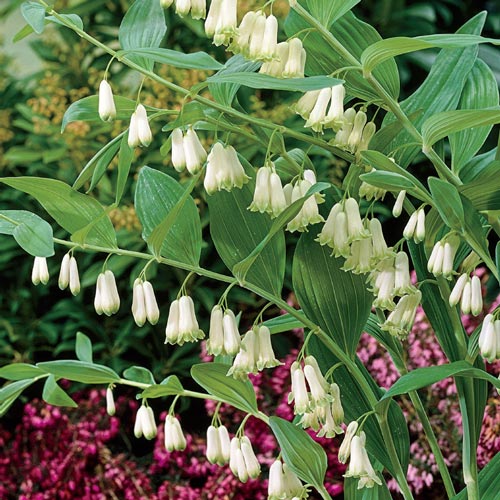Solomon's Seal Plant A Woodland Treasure
The existence of Solomon's Seal Plant extends centuries into the past while its name remains connected to both folklore and traditional healing practices. The plant originates from North America, Europe and Asia and made its first appearance in medieval herbal documentation. Long before botanical records documented its presence indigenous peoples and early settlers knew about its healing properties. The root of the plant was said to be marked with King Solomon's seal while it stood as a symbol of wisdom and protection, according to legends.
European botanists formally recorded the plant during the 17th and 18th centuries because its elegant stems and medical uses fascinated them. People throughout history have used this plant's remedies to treat various ailments, which led to its inclusion in herbalists' and physicians' apothecaries.
Solomon's Seal Plant Medicinal Uses Through the Ages
People have respected this plant for its healing benefits for hundreds of years. North American Indigenous tribes applied rhizomes from this plant as poultices for wound healing as well as treatment of bruises and inflammation. The root with mucilage properties provided relief for digestive problems as well as respiratory conditions such as coughs and bronchitis. The plant serves as a yin energy nourisher in Chinese medicine which helps treat dryness and fatigue while also balancing blood sugar levels.
European folk practitioners identified its potential to heal bones and tendons. It received regular applications to sprains and sore joints because of its anti-inflammatory properties. As time passed this treatment became widely used for skin irritations as well as burns and acne. The plant remains popular for creating tinctures and salves which maintain joint health and strengthen connective tissues in modern herbalism.
Discovery and First Botanical Records
This plant received formal botanical documentation in the 16th and 17th centuries even though indigenous cultures had known about it for centuries before European settlers arrived. The English herbalist John Gerard wrote about the plant's medicinal benefits in his well-known Herbal (1597). The father of modern taxonomy, Carl Linnaeus, provided the scientific classification of this plant during the 18th century which secured its acceptance in scholarly research.
The fact that this species exists in temperate forests globally indicates its successful existence long before humans began recording its presence. Millions of years ago, fossil records show that this plant's relatives coevolved in forest environments. The species maintains its critical role in supporting diverse forest floor ecosystems today.

A Versatile Addition to Landscapes
This woodland plant is highly valued by gardeners and landscape designers because it adds elegance and structure to shaded garden spaces. The plant attracts enthusiasts of lush tranquility because its arching stems and bell-shaped flowers deliver a gentle natural beauty.
Solomon's Seal Plant develops best in shaded and partially shaded locations where it creates an impressive ground cover. When combined with ferns and hostas along with other shade-loving perennials this plant produces a dynamic landscape with multiple layers. Its capacity to fill spaces under trees and shrubs makes it an essential plant for adding depth and texture to cottage gardens, woodland borders, and naturalized settings.
This plant needs minimal attention after it establishes itself which makes it perfect for gardens that require little upkeep. The plant spreads gradually via underground rhizomes which enables natural establishment over time while enhancing its appeal as both a graceful and hardy addition to gardens.
The Graceful Beauty of Solomon's Seal Plant Form
The plant's elegance emerges from arching stems which stretch up to three feet tall. The stems display alternating lance-shaped leaves that stay vibrant green during the entire growing season. Tiny lantern-like flowers gracefully dangle beneath the leaves as they appear in spring. The plant displays creamy-white bell-shaped flowers that emit a delicate fragrance which enhances its overall attractiveness.
When autumn approaches the leaves change to warm golden yellow which creates a striking contrast effect in shade gardens. The plant develops small deep-blue or black berries by late summer which continue to make an attractive display throughout the cooler months after the flowers have faded. The plant's changing appearance throughout different seasons makes it an adaptable choice for gardeners who desire continuous garden appeal.
A Magnet for Rare Wildlife
This attractive woodland plant provides essential benefits for local wildlife beyond its visual appeal and medicinal properties. Pollinators including bumblebees and native solitary bees find nourishment from the fragrant flowers' nectar. Ecosystem health and plant support depend on these pollinators.
Certain bird species such as thrushes and woodland songbirds consume berries from this plant that ripens during late summer. Bird species consume its seeds from the berries and distribute them across natural environments which maintains its presence there.
Solomon's Seal Plant gains additional ecological significance because moth larvae of certain species treat it as their host plant. Any garden targeting biodiversity benefits from this plant because it offers essential food and shelter.
Solomon's Seal Plant A Plant of Timeless Value
This woodland perennial demonstrates time-tested resilience through its historical importance, medicinal value, and ornamental use. The plant remains a fundamental feature of gardens and natural settings because it improves shaded areas and supports pollinators while delivering continuous visual appeal.
Solomon's Seal Plant holds an unbroken legacy through its historical depth and garden elegance while supporting wildlife populations that persist in today's environment.